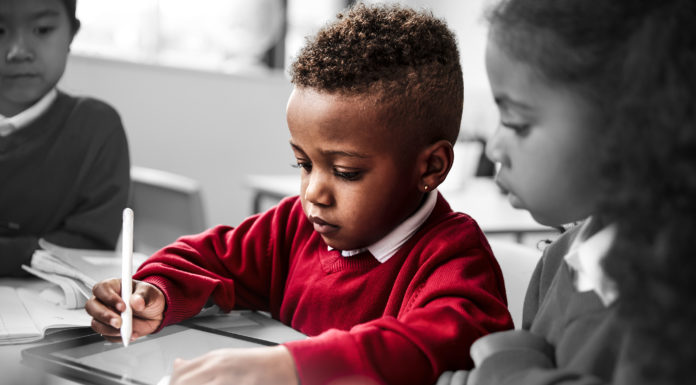Remote learning is now underway for students across the country. Before it even began, there were more questions than answers, more anxiety than normal and more aspects of uncertainty than ever before.
Now that we’re a week into remote learning in Chicago, none of that has changed.
This year, I’m wearing multiple hats, just as many of us are. I’m a single mother, in education, working from home.
I hadn’t contemplated my whole life’s existence this much until last week.
Being a mother, an educator and now a leader in the school I serve in, I also get to see things through various lenses. The lenses in the glasses I wear for one of my roles are no clearer than the other and as the second week of remote learning begins here in Chicago, I am awake way later than I should be, trying to make sure I do all three jobs to the best of my ability.
As a mother, remote learning is challenging. Forget that I’m an educator, because honestly, I’m not able to be that to my daughter during the school day. Yes, we are both at home. But we might as well be in two different worlds, with her being in her room at her desk and me in the family area at mine. She often complains that she hears me and the teachers and students at my school and that she can’t focus on work with the limited time she has with her teachers. While I may be working “at home,” I might as well be in another building because my role as an employee requires my full attention during school hours.
As an educator and instructional leader of my school, I’m tasked with the responsibility of ensuring students receive an education that is comparable to what they would receive in the school. Yet, this past week, I’ve realized that that just isn’t possible. We aren’t in school and what we’re trying to do for kids isn’t replicate school. We must look at learning differently.
The babies I serve (no matter how old they are, they will always be “babies”) are trying their best. Many times, there are multiple students in one family, on multiple devices, hearing multiple teachers throughout the rooms of the house. There may be parents and guardians who are able to help, but many times, there aren’t. We have been tasked to try as hard as we can to replicate the school day with synchronous and asynchronous learning, using materials and programs that simulate instruction digitally. As an educator of Black boys and girls, it’s essential to me that our babies do not lose more ground this year. However, with 39 more weeks in this school year, I admit that there are a few things that need to change.
- Give grace and patience.
This time is difficult for everyone. The reason WHY we’re even learning remotely is because we are in the midst of a pandemic. A pandemic. That means that people are not well, whether physically or emotionally. Lives have changed greatly in the last few months. Please, let’s give grace and patience to our students and families. Some days, “school” is the last thing on their mind. (This includes teachers – we have families too).
- Don’t require cameras to be turned on.
I completely understand the mandate for cameras to be on. In some ways, it signals “engagement”. Yet for many families I serve, that doesn’t equate engagement but can be a source of anxiety. Everyone lives differently. And sometimes, what I see beyond the faces of the students isn’t what I know they want others to see. It’s not only inequitable to require all students to have their camera on, its also punishment. The countless memes and degrading images of what could happen when cameras are on wouldn’t even be if schools and leaders took into consideration the families and students they serve. Everyone doesn’t have a blank wall and quiet space to learn. Even I need to turn my camera off at times and I’m a “professional”.
- Students don’t need to be at the screen for 6 hours a day.
Remote learning isn’t the same as learning in school. I’ll say that again for the people in the back. Remote learning shouldn’t be the same as learning in school. Teachers don’t have the same resources nor are we equipped to tackle the external environmental challenges that arise during this time. Requiring students to have 6+ hours of screen time is not only unreasonable, it’s not conducive to actual learning. How are we accommodating various learning styles? What about students who are visually challenged? Those who need accommodations and modifications? Many of the students I serve are simultaneously learning how to use technology past browsing and accessing videos. We may have a generation that was born into technology but that doesn’t mean they know how to use the technology we’re asking them to.
- Parents are “in” school with their children as well, don’t forget about them.
This school year, the adage of parents being the first teacher has more truth than ever. And we haven’t prepared parents. Parents are frustrated. Parents are not only trying to keep their family safe, they are also trying to keep up with the assignments and learning plans for their children. And parents aren’t teachers. I may have been a teacher for 10+ years before the pandemic, but even in this capacity, I’m not a teacher. I can’t be a teacher at this time, even though I went through years of education on pedagogy and best practices on curriculum and instruction.
If we aren’t tasking ourselves as leaders in education to also teach our parents this school year, we’re completely missing the mark.
With more weeks ahead of us than behind us, I’m hopeful and exhausted. As a parent, I can’t imagine continuing in this way and as an educator, I know that some changes that are needed are beyond my control. For now, I’ll try my best to be everything I can for my daughter and the other children, but I’ll be extending grace to myself and her. And if that means she needs to walk away from the screen, turn it off and work or just complain about how unfair this is, I’m here for her as her mother first – knowing that this year is difficult for us all.









